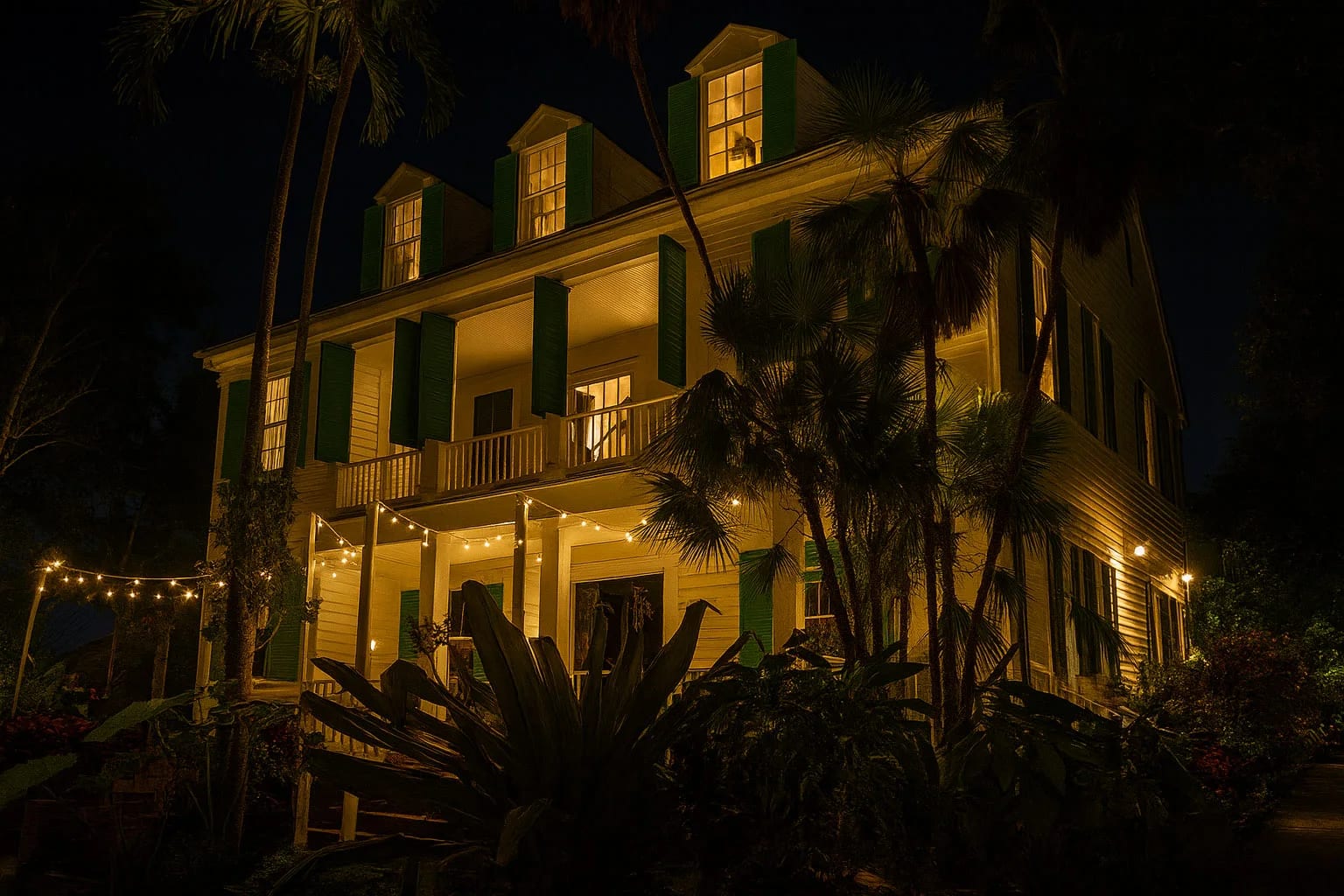The Audubon House sits at 205 Whitehead Street, a pristine example of 19th-century Key West architecture surrounded by gardens that bloom year-round with tropical flowers. Visitors come to admire the period furnishings, the extensive collection of Audubon prints, and the immaculately maintained grounds that offer a rare glimpse of what wealthy Key West looked like in its wrecking heyday.
But many visitors leave with stories that have nothing to do with art or architecture. They speak of seeing a distinguished-looking man in the upstairs windows when the upper floor is known to be empty. They describe feeling watched while touring the house, as if the homeowner is keeping a careful eye on his guests. They report encountering a presence in the gardens—not threatening, but definitely there—as if someone is tending the plants and checking that everything is in order.
This presence is believed to be Captain John H. Geiger, the man who built this house and raised his family here, accumulating wealth through his dangerous work as a harbor pilot and wrecker. Geiger loved this house and these gardens, and according to those who work here, he still does—so much so that death has not ended his proprietorship.
The History of the Audubon House
Captain John H. Geiger built this house in the 1840s during the height of Key West's wrecking era, when the island was the wealthiest city per capita in the United States. Geiger was a harbor pilot and wrecker, two professions that were both lucrative and dangerous in 19th-century Key West.
As a harbor pilot, Geiger guided ships through the treacherous coral reefs and channels around Key West, using his intimate knowledge of the waters to prevent groundings. As a wrecker, he salvaged cargo from ships that ran aground despite the best efforts of pilots, earning significant compensation for rescuing valuable goods from the sea.
Geiger was successful at both professions, accumulating enough wealth to build one of Key West's finest homes. He designed the house in the Classic Revival style popular at the time, with wide verandas to catch the tropical breezes, high ceilings to allow heat to rise, and large windows that brought light into every room. The house was built from materials shipped from other ports—lumber from the northern states, bricks ballast from European ships, and hardware ordered from catalogs.
Geiger filled his home with a large family and maintained extensive gardens where he grew tropical plants, fruit trees, and flowers. The house became a showplace, demonstrating what Key West's wrecking wealth could create. Geiger lived here for decades, raising his children, entertaining guests, and enjoying the fruits of his dangerous labors.
Captain John H. Geiger
Captain Geiger was known as a skilled and respected pilot and wrecker, a man whose knowledge of Key West's waters was encyclopedic. He understood the coral reefs, the channels, the currents, and the weather patterns that made navigation around the island so treacherous. This knowledge made him invaluable to ship captains and profitable to himself.
Beyond his professional success, Geiger was a devoted family man who took great pride in his home and gardens. He personally designed the garden layout, selecting plants that would thrive in Key West's climate and creating a tropical paradise that was rare in the 1800s when most yards were simple sand lots.
Geiger's attachment to his home and property was well known among his contemporaries. He spent his free time in the gardens, meticulously maintaining the plants and constantly improving the grounds. The house was his greatest achievement—proof that a man could come to a frontier island and create something beautiful and lasting.
This intense attachment to the house may explain why his spirit seems unable or unwilling to leave. The Audubon House wasn't just a building to Geiger—it was the physical manifestation of everything he had worked for, everything he had built, and everything he loved. In death as in life, he remains its devoted guardian.
The Audubon Connection
The house's name comes from naturalist John James Audubon, who visited Key West in 1832 while researching his monumental work 'The Birds of America.' Audubon never lived in this house—it hadn't been built yet when he visited—but he did explore Key West and the surrounding keys, observing and painting the tropical birds that would become some of his most famous works.
When the house was restored and opened as a museum, it was named the Audubon House and filled with original Audubon prints and memorabilia, creating a connection between the famous naturalist and this beautiful example of Key West architecture. The collection includes numerous original Audubon prints valued at millions of dollars, making the house both a historic site and an art gallery.
The presence of Audubon's work throughout the house may add another dimension to its spiritual atmosphere. Art, particularly pieces created with such passion and skill as Audubon's bird paintings, is believed by some to carry its own energy. Combined with Captain Geiger's protective spirit, this creates a location rich in positive but powerful spiritual presence.
The Spirit of Captain Geiger
The haunting at the Audubon House is remarkably focused—it's primarily the story of one spirit, Captain Geiger, who has chosen to remain in his beloved home.
Sightings of Captain Geiger
Captain Geiger's spirit is most commonly seen in the upstairs windows of the house, appearing as a distinguished-looking man in 19th-century clothing who seems to be surveying his property. Witnesses report that he appears solid and three-dimensional, looking like a living person until he suddenly vanishes or until the observer realizes that no one should be in that area of the house.
Museum staff report that these sightings are most common in the morning and evening—times when Geiger, in life, would have been checking his property before leaving for work or returning home. The spirit seems to follow the routines of life, maintaining a schedule even in death.
Some visitors report encountering Captain Geiger inside the house, describing a well-dressed man who appears to be inspecting the rooms or examining the furnishings. When spoken to, he doesn't respond, and when approached, he vanishes. These encounters are brief but vivid, leaving witnesses convinced they've seen something supernatural.
The Watchful Presence
Even when not visibly manifesting, Captain Geiger's presence is felt throughout the house. Tour guides and museum staff describe a constant sense of being observed, particularly when alone in the house. They report feeling someone watching them, checking that they're treating the house properly and respecting its history.
This presence isn't threatening—those who work at the Audubon House describe it as protective and proprietorial, like a homeowner keeping an eye on guests to ensure they don't damage anything. Staff members generally feel comfortable with Captain Geiger's spirit, viewing him as a benign guardian rather than a threatening entity.
Visitors frequently report the same sensation of being watched, particularly when they spend time alone in certain rooms or when they examine Captain Geiger's personal items and family photographs. Some describe feeling as if someone is standing just out of sight, observing them carefully.
The Garden Guardian
Captain Geiger's spirit is perhaps most active in the gardens he loved so much in life. Groundskeepers and gardeners who maintain the property report sensing a presence while they work, as if the original gardener is supervising their efforts. Some describe feeling guided to work on particular plants or areas, as if an invisible hand is directing them to spots that need attention.
Visitors walking through the gardens sometimes encounter the scent of tobacco—Captain Geiger's preferred vice—despite smoking being prohibited on the property. Others report seeing a shadowy figure moving among the plants, disappearing when observed directly. The figure appears to be tending the garden, checking the plants and moving along the paths with the purposeful stride of someone who knows every inch of the property.
Photographs taken in the garden occasionally show unexplained anomalies—orbs, mists, or shadow figures that weren't visible to the photographer. These phenomena cluster in areas where Captain Geiger reportedly spent the most time, suggesting his spirit continues to frequent his favorite spots.
Protective Actions
Captain Geiger's spirit seems to take an active role in protecting his house and property. Staff report that when visitors behave inappropriately—touching things they shouldn't, being disrespectful, or attempting to take items—unexplained things happen. Objects move, alarms sound for no reason, or the offending visitor experiences a sudden compulsion to leave immediately.
On one memorable occasion, a visitor who attempted to pocket a small item from the house reportedly felt an icy hand grip his wrist. When he looked down, no one was touching him, but the sensation was so strong and unpleasant that he immediately returned the item and left the property, badly shaken.
These protective manifestations suggest that Captain Geiger remains deeply invested in preserving his home, acting as an eternal watchman who ensures his property is treated with the respect he believes it deserves.
Visit the Audubon House
The Audubon House is located at 205 Whitehead Street in Key West and operates as a museum and tropical gardens open to the public. Visitors can tour the beautifully restored home, view the extensive collection of Audubon prints, and explore the lush gardens that Captain Geiger loved so much.
Our Ghosts of Key West Tour stops at the Audubon House, where our guides share the story of Captain John H. Geiger, his successful career as a pilot and wrecker, and the beautiful home he created. We discuss the numerous encounters with his spirit and explore why some people become so attached to their homes that they choose to remain there even after death.
Join our Ghosts of Key West Tour to learn about the Audubon House and discover why Captain Geiger's spirit continues to watch over the property he built and loved for so many years.

